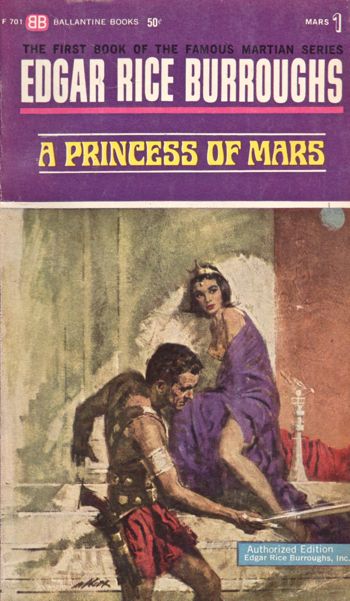
by Mx. Kris Vyas-Myall
Whilst reading the Times a couple of months I was surprised to see a mention of my favourite SF periodical turn up.
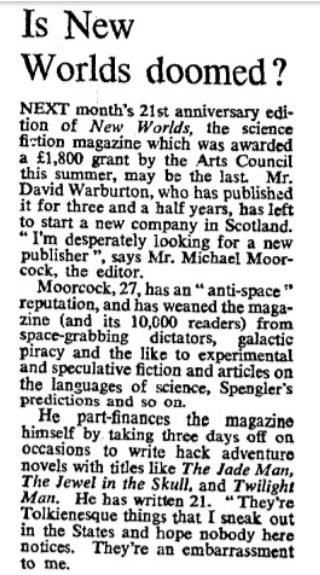
As regular readers of the publication will know they have managed to get a new publisher (Stonehart) and are continuing on with only a single month’s break to reorganize. What interested me most was the third paragraph, that there were some more adventure stories he was writing specifically for the US market. I have not come across The Jade Man yet but The Twilight Man actually is the book form of his The Shores of Death already released.
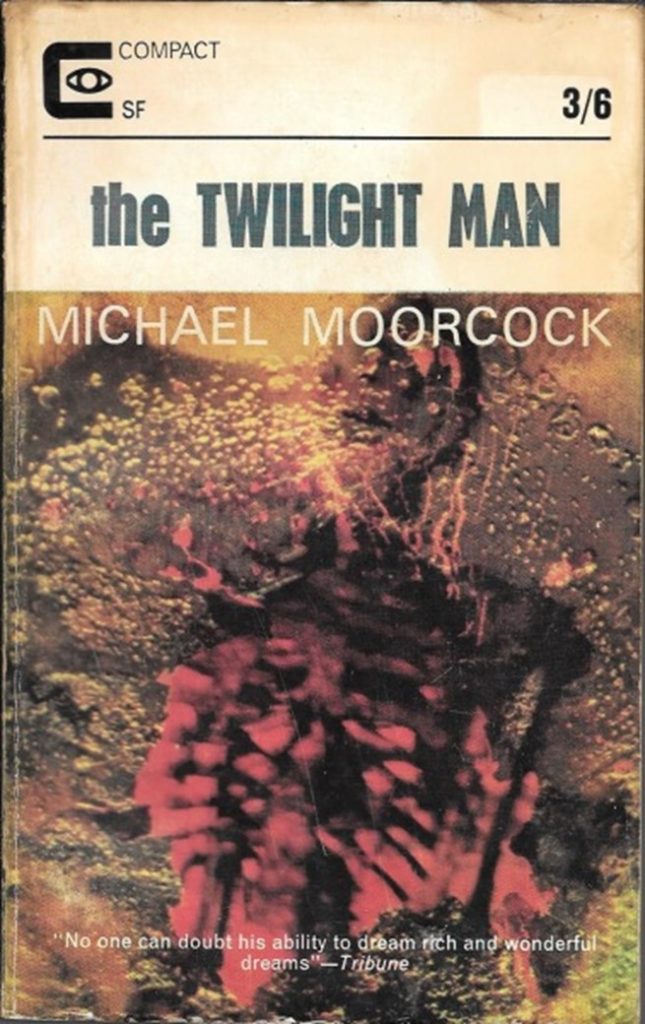
And I was able to discover that The Jewel in the Skull was coming out in America in December.
Now Moorcock’s adventure stories are a mixed bag. For every Elric there is a Michael Kane. But with such an anti-endorsement from the writer himself, how could I not want to read it?
The Jewel in the Skull by Michael Moorcock
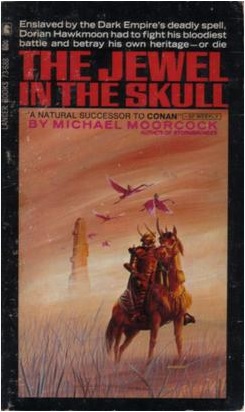
In one of my favourite kind of settings, post-apocalyptic fantasy, the world has returned to a state of medieval kingdoms fighting each other, with modern technology treated as ancient sorceries people struggle to understand.
This book is primarily set in the Europe of this future, where the dark empire of the Granbretans is attempting to conquer the continent in the name of its King-Emperor. The powerful kingdom of Kamarg remains independent with Count Brass and his fortress of Castle Brass. Baron Meliadus of Kroiden attempts to gain their support for the empire but is thrown out when he attempts to rape the Count’s daughter Yisselda. Swearing an oath by the Runestaff to control the count and seize his daughter for himself he concocts a plan to do so.
In the dungeons of Londra is the rebellious Duke of Köln, Dorian Hawkmoon. He gives Hawkmoon an offer he can’t refuse, granting him his lands back and his freedom if he goes to Castle Brass, kidnaps Yisselda and brings her back to London. As additional motivation, a black jewel is implanted in his skull. This will allow the Granbretans to monitor him at all times and they can also use it to destroy his mind whenever they choose. And so Hawkmoon rides to Castle Brass on this fraught mission.
When I first opened this book I was worried this was going to be another Barbarians of Mars, with some incredibly overwritten descriptions and cod-Shakesperean dialogue. Thankfully, the style soon settles down and we get something much thicker than the Sub-Tolkien fantasy at first suggested. In fact there are some wonderful choices of imagery, a kind of combination of the gothic and the psychedelic.
As you can probably see from the description, this is not a setup where there are any easy heroes. It is also fascinating to see a tale where the British are explicitly setup as “The Dark Empire”, with people regularly suggesting the entire nation has gone insane and our representative of them a manipulative rapist. Instead, our lead character is a German, the inverse of what you will see whenever you go to the cinema.
This is only the first story in a series, so there is a lot left to be told, but, overall, this is an interesting and entertaining fantasy.
Four stars

by Victoria Silverwolf
Synchronicity
As fate would have it, I recently read two new science fiction novels featuring psychiatrists named Paul. In addition to that, both protagonists are involved with women who have a hard time pronouncing that name. Other than this odd coincidence, the books have little in common, except that they both involve people who have traveled a long distance.
A Far Sunset, by Edmund Cooper

Uncredited photographic cover art.
Split Personalities
The first mental health professional we'll meet is Paul Marlowe. He's a psychiatrist aboard the starship Gloria Mundi. (Given the familiar Latin phrase containing those words, that seems like asking for trouble.)
When the novel opens, he's in prison on an alien world. Two other members of the crew, captured at the same time, are dead. Before all this happened, the nine remaining folks aboard the ill-fated vessel disappeared while exploring the planet. For some reason, the locals have supplied him with a concubine, even in prison. That's the woman who can't pronounce Paul correctly. Her name, by the way, is Mylai Tui.
Meanwhile, Gloria Mundi destroys itself, as it's programmed to do when all the crew is gone for a certain amount of time. Sounds like a design flaw to me, but the idea is to keep it from falling into the hands of hostile aliens.
With no way to return to Earth, Paul Marlowe decides to fit into his new world. He does this by creating a second self, in a way. When acting like one of the locals, he calls himself Poul Mer Lo. This mental exercise allows him to control his emotions when witnessing things like child sacrifice.
(I couldn't help wondering if this was a sly allusion to Poul Anderson, whose first name is famously difficult to pronounce unless you're Scandinavian.)
Paul pretty much accepts Mylai Tui as his wife, although he was already married to one of the missing crew members. The marriage was one of convenience, mostly, although the two were fond of each other. Paul left his true love back on Earth, because he wanted to travel to the stars so badly. Be careful what you wish for!
A parallel to Paul's double identity is found in the local god-king, a young man who often takes on a second persona as a peasant, in order to speak freely with Paul in a way he can't as a divine ruler. Their relationship, in which the god-king is eager to learn Earth ways from Paul, may be the most intriguing part of the book. It also creates some suspense, as the god-king is only allowed to rule for a year, after which he is ritually killed.
The plot really begins when Paul and some local companions make a dangerous journey through enemy territory and deadly jungles to an ice-covered mountain. He makes an extraordinary discovery, learns what happened to the missing crew members, and even finds out why the inhabitants of the planet are very similar to Earthlings but have only four fingers on each hand.
The alien culture is interesting and vividly portrayed. Paul is not a very sympathetic protagonist. He beats Mylai Tui when she struggles to pronounce his name correctly, for one thing. The latter half of the book turns into a quest adventure, which is fine if you like that sort of thing. The revelation at the end of the trek to the mountain strains credibility. Overall, a mixed bag.
Three stars.
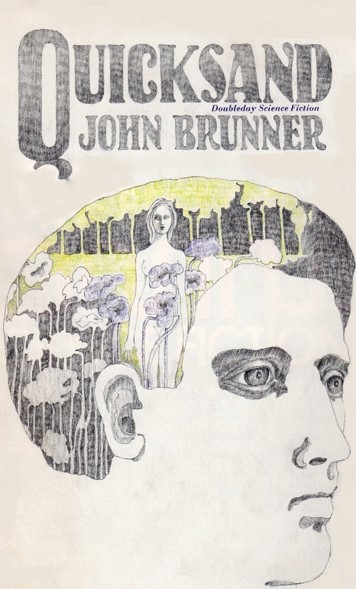
Cover art by Emanuel Schongut.
Physician, Heal Thyself
Our next psychiatrist is Paul Fidler. He works at a mental hospital. You'll get to know him well, because much of the book consists of his interior monologues. They're set off from the rest of the text in the manner I'll demonstrate in the next paragraph.
–I hope the editor likes this article.
Paul has doubts about his career and his marriage. He also has a habit of imagining the way that things might have gone badly in the past. It's kind of the opposite of the wistful thinking we probably all do. You know, something like If only such-and-such had happened. Besides all this, he hides the fact that he had a nervous breakdown some time ago from everyone, even his wife.
After spending some time with this sad fellow, the plot gets going when a badly injured man staggers into a pub. He claims a naked woman attacked him. Could it be one of the inmates at the hospital?
Nope. Paul soon runs into the woman, a tiny little thing, sort of like the diminutive Sister Bertrille. Don't worry, she doesn't fly.
As I've indicated, she has trouble saying Paul correctly. She speaks an unknown language, but manages to indicate that her name is Arrzheen. That gets distorted into Urchin by the folks at the hospital, which fits her pretty well.
Much of the book deals with Paul's attempt to solve the mystery of Urchin. What was she doing naked in the woods on a cold, rainy night? How did such a small woman, who hardly seems out of her teens, severely injure a much bigger man? (We'll find out later it was self defense.) Why can't expert linguists identify her speech or her written language? Why does she seem baffled by ordinary objects?
A strange form of mental illness, or something else? (Hint: this is a science fiction novel.)
Urchin proves to be extraordinarily intelligent, and she picks up English quickly. Paul's marriage falls apart completely. Through the use of hypnosis, he learns more about Urchin. He tries to help her adjust to the outside world.
Let's just say that things go a little too far. After some misleading hints about Urchin, we find out the truth at the very end. Don't expect a happy ending.
As with the Cooper's novel, the protagonist is not always very likable. What he does at the end may disturb you. The book seems almost like introspective mainstream fiction, with a science fiction premise forced into it. It's more to be admired than loved, I think.
Three stars.

by Gideon Marcus
The fourth book for this Galactoscope turns out to be another kind of fourth book: Emil Petaja has written the fourth (and final?) book in his science fiction translation of the Finnish national epic, The Kalevala. It's an unusual novel in that it stars a villain, of sorts. Let's learn more about the…

Kullervo Kasi is a most unlovely man. Born of the chance interaction between a rent in the universe and a random act of sex, he is half human/half evil energy. Physically, he is a gnome-like character, though not without a strong back. Humans instinctively recoil from him. When we first meet him, he is on one of the thousands of colonies of humanity, the race exiled to the stars after their home world had been exhausted. Kullervo is bullied near to death, from which he escapes by a jump into a chasm to (he believes) his doom.
But Louhi the star witch has other plans. She takes Kullervo under her wing, unlocks the intelligence lying dormant in his genes as the reincarnation of the ancient Kalevalan anti-hero, Kullervo, and sends him to the wasted Earth. His mission: to destroy any remnants of humanity–the Vanhat race–that may yet survive on the ruined world.
This is for whom we should be rooting?
Well, yes. It's hard not to feel sorry for Kullervo. He was born with a handicap; his human tormentors have no such excuse. Once he arrives on Earth, and through cunning, endurance, and not a little (if grudging) selflessness, surmounts obstacle after obstacle, one can't help admiring the guy. In the end, if he is not exactly the hero of the story, he certainly is the catalyst for a great good.
Such an unusual protagonist is refreshing, indeed. Plus, Petaja really can spin a quill, offering a neo-pulp adventure with a mythical base. His depictions of the rusting supercities, the floating junk islands, and the recovering crags of Scandinavia have a rich, Burroughsian flavor. I particularly enjoyed Kullervo's adventures with Billyjo, a renegade coast-dweller. Their run-in with the pirates of the roving islands, and Kullervo's short-term subjugation to Queen Fiammante, reminded me somewhat of my favorite Baum book, John Dough and the Cherub. I also found interesting the implication that Kullervo, hideous as he was, had a strange appeal to women–both Fiammante and Louhi make him their lover, and the people who treat Kullervo poorly are invariably men.
Tramontane is not a great book: for one thing, it's not science fiction, but space opera. It's also not consistently written: the middle third is excellent, but the last third lags a touch and is quite literally a deus ex machina situation. Still, it is a thoroughly enjoyable book, and it stands well enough alone (I haven't read any of the other books in the series: Saga of Lost Earths, The Star Mill, or The Stolen Sun.)
Three and a half stars.
(Note: Tramontane comprises one half of Ace Double H-36; the other half is Moorcock's The Wrecks of Time, previously reviewed by Mark Yon. The Ace version has apparently been butchered to fit the format, the greatest casualties being the naughty bits.)


by Cora Buhlert
Sex in the Real World

The most shocking film of the year is currently playing in West German cinemas. It's called Helga – Vom Werden des menschlichen Lebens (Helga – About the Development of Human Life) and has caused scores of cinema goers to faint.
But what exactly is so shocking about Helga? Well, Helga is a movie about – gasp – sex. The plot is simple. An interviewer asks pedestrians in the street about sex education and birth control. Next we meet the protagonist: Helga (newcomer Ruth Gassmann), a naïve young woman pregnant with her first child. Like many women, Helga knows very little about her body and what is happening inside her womb. Luckily, a kindly gynecologist explains the mechanics of conception and pregnancy to Helga and the viewer. The movie then follows Helga through her pregnancy and also documents the birth of her child. It's this birth scene – shot in full, gory detail – that makes particularly male viewers faint in the cinema… and hopefully think twice before impregnating a woman.
In spite of the frank scenes, Helga is not pornography, but an educational film intended to teach West Germans about human sexuality. Shot in a pseudo-documentary style and interspersed with animations showing the human reproductive system, Helga does what parents and schools all too often fail to do, namely teach young and not so young people about their bodies. The film was produced by West German Secretary of Health Käte Strobe, a sixty-year-old lady from Bavaria and unlikely champion of sex education.
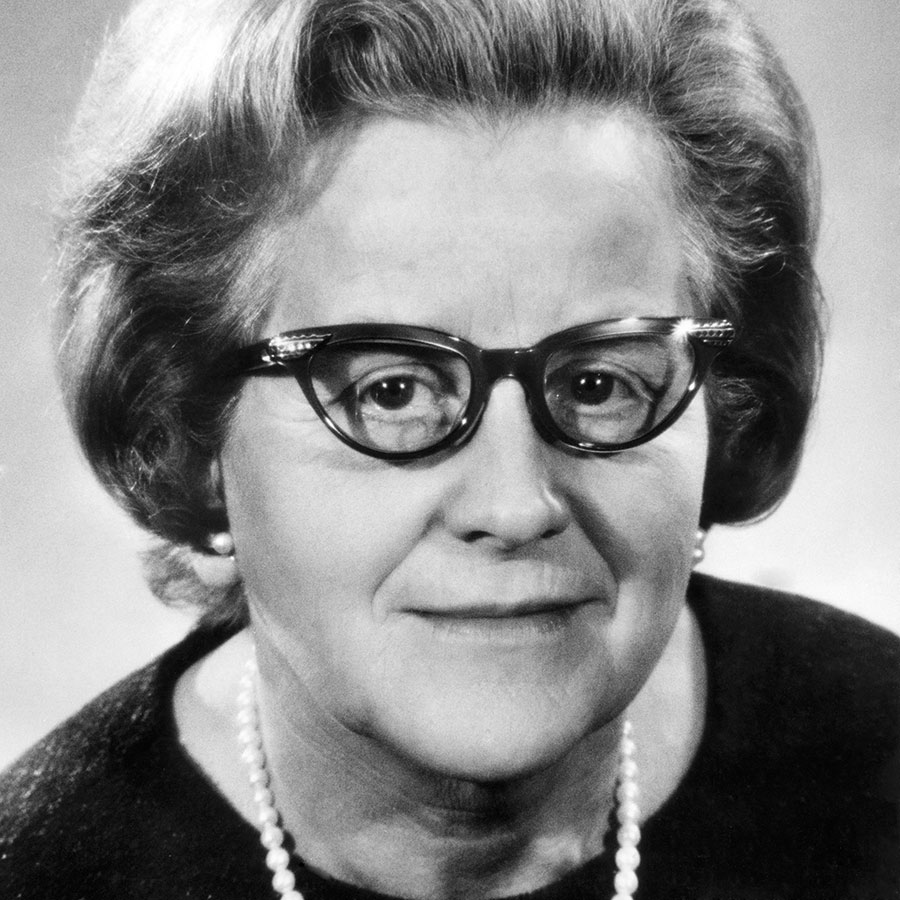
But don't take my word for it. Because American International has purchased the distribution rights for Helga, so you can soon see it in a theatre near you.
Sex on an Alien World: Outlaw of Gor by John Norman
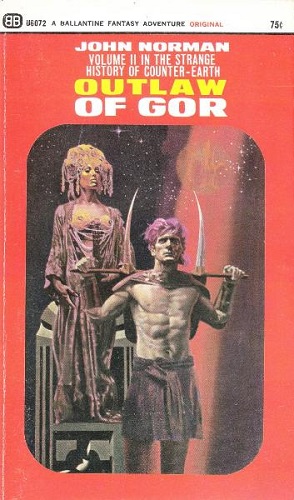
I wasn't enamoured with John Norman's debut novel Tarnsman of Gor and didn't plan on reading the sequel. However, December 6 is St. Nicholas Day and since St. Nick was kindly enough to put a copy of Outlaw of Gor into my stocking, I of course felt obliged to read and review it.
When I reviewed Tarnsman of Gor earlier this year, I noted that John Norman was obviously inspired by the Barsoom novels of Edgar Rice Burroughs. This influence is even more marked in Outlaw of Gor, for while Tarnsman opened with protagonist and first person narrator Tarl Cabot, Outlaw uses a Burroughs type framing device and opens with the statement of an attorney named Harrison Smith, who describes at great length his relationship with Cabot, Cabot's physical appearance, his mysterious disappearance and reappearance.
Years later, Cabot and Smith rekindle their acquaintance. Eventually Cabot hands Smith the manuscript for Tarnsman of Gor and vanishes again. Smith publishes the manuscript, as the law of framing devices demands, as well as the sequel, which he finds waiting for him on his coffee table.
It is helpful to briefly recapitulate the previous book in an ongoing series for the reader, but the statement of Harrison Smith goes on for pages upon pages. Nor does the novel need a framing device, because this is 1967, not 1912, and readers are accustomed to fantastic adventures in alien worlds by now.
A Gorean Travelogue
The story proper finally starts with Tarl Cabot giving us an extended description of the Gorean scenery, customs, flora and fauna. One of my complaints about Tarnsman was that the opening third of the novel was a dull and interminable lump of information, because Norman was an inexperienced writer uncertain how to present information about his world to the reader. I had hoped that Norman's writing skills would have improved by his second book. Sadly, they have not.
After a trek through the wilderness, Tarl Cabot finds his hometown Ko-Ro-Ba destroyed by the Priest-Kings and its people, including Cabot's father and his mate Talena, scattered to the four winds. Cabot himself is now an outlaw and decides to avenge himself on the Priest-Kings. Again, the parallels to Burroughs are notable, because John Carter also found himself separated from his hometown and wife upon his return to Barsoom and forced to deal with overbearing godlike beings in The Gods of Mars back in 1913. Indeed, many things in Tarnsman and Outlaw of Gor only happen to Tarl Cabot because they happened to John Carter first.
Before meeting the Priest-Kings, Cabot pays a visit to the city of Tharna, which is remarkable for two reasons. One, all Goreans, regardless of their origin, are welcome in Tharna. Two, Tharna is ruled by a woman and – unlike the rest of Gor – women are revered in Tharna and not treated as slaves or possessions.
It's a Women's City… or is it?
The position of women and the institution of slavery on Gor played an important role in Tarnsman and crops up again in Outlaw. And indeed, the descriptions of Gorean slave girls seem to be what attracts many readers to these books. As a modern man of the Sixties, Tarl Cabot abhors slavery and the oppression of women in general, though it is not clear, if the author shares these views, since the narrative repeatedly notes that the slave girls are happy with their lot after initial resistance and that the free women of Gor, who are kept locked up and only venture outdoors in heavy veils, comparable to practices in many Moslem countries, which are thankfully modernising, secretly envy the slave girls their relative freedom. These aspects make the Gor books more disturbing than a simple Burroughs pastiche should be.
Compared to other Gorean cities, Tharna is described as a grey and depressing place full of grey and depressed men. Apparently, treating women like human beings tends to make cities grey and men depressed. In general, Cabot seems inordinately concerned with cities and their appearance, at one point comparing the run-down New York City unfavourably to Gorean cities. I wonder if Cabot (and his creator) blames women for the sorry state of New York City, too.
Revenge of the Masked Lesbians
Cabot has only been in Tharna for a few hours, when he is approached with an offer to kidnap the Tatrix Lara, the city's ruler. He refuses, finds himself framed for a crime and condemned to die in the arena for the amusement of the Tatrix and the haughty masked women of Tharna. Cabot also learns the reason why Tharna is uncommonly hospitable towards strangers – because they are enslaved to labour in the fields or mines. What is more, men are viewed as little more than animals in Tharna and the women are forbidden from loving men, though encouraged to love each other.
Cabot manages to escape with the help of his tarn, the giant bird creatures warriors of Gor ride into battle. However, rather than continuing his journey to see the Priest-Kings, Cabot instead decides to liberate Tharna from the haughty masked lesbians. Needless to say he succeeds and decrees that what the masked lesbians of Tharna need is a man and some good old fashioned Gorean slavery to teach them how to love. Reader, I puked.
Honestly, just read Burroughs
Tarnsman of Gor was mildly spicy Burroughs pastiche. But while John Norman's fascination with slavery, whips, hoods and shackles was already evident, I did not sense anything prurient or anti-feminist in Tarnsman.
Outlaw, however, is another matter. Particularly the second half of the novel and its anti-feminist conclusion gave me the same creepy crawly feeling that Piers Anthony's Chthon did. Worse, since Cabot has neither found the Priest-Kings nor his true love Talena by the end, I fear there will be at least one more Gor book. However, I will not read it.
If you like swashbuckling adventures on alien worlds, Edgar Rice Burroughs' entire catalogue is back in print and the excellent planetary adventures of Leigh Brackett are easy enough to find as well. If you like the spicier aspects, there is plenty of sleaze to be found in the paperback spinner racks, some of it – so I am reliably informed – written by genre stalwarts such as Robert Silverberg and Harlan Ellison under pseudonyms.
However, don't bother with Outlaw of Gor or its predecessor.
One star.
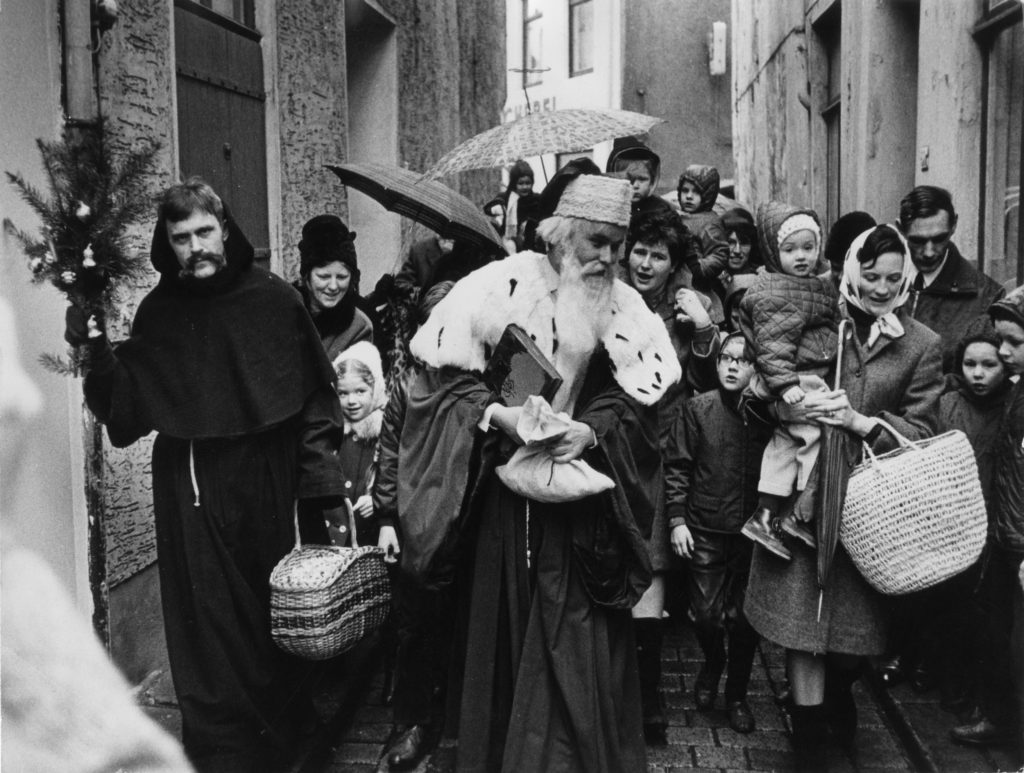

by Jason Sacks
Secret of the Marauder Satellite, by Ted White
There's a new novel out by Ted White, the longtime assistant editor for The Magazine of Fantasy and Science Fiction. Despite its goofy title, the new Secret of the Marauder Satellite is a wonderful quick read with some clever turns of phrase and interesting insights into its lead character.
Our lead is a young man named Paul Williams, recently graduated from "space cadet" school (as he half-dismissedly calls it) and ready for his first major assignment, aboard a satellite orbiting the Earth which also works as a staging site for mankind's further trips through the Solar System.
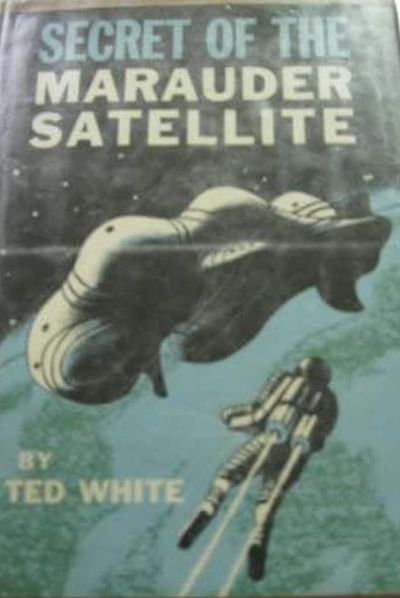
As you might imagine from a book like this, Paul is a bit of a prodigy in a space suit. He receives a plum assignment, as a roving salvage man assigned to pick up space junk and haul it back to the station for recycling. With resources short on the station, such a job is extremely useful and important. But during his second mission in that role, Paul makes a fateful and surprising discovery which indicates mankind might not have been the first race to orbit Earth's moon.
White separates his prose from his peers with its vividness of description and clever ways he brings common events to life. For instance, he explains why rocket launches require countdowns in the kind of matter-of-fact detail that had me nodding my head, and his explanation of gravitational inertia is as elegant as it is concise.

But the element that really elevates this book is the way White explains Paul's inner life. We learn early on that Paul is an introvert and has trouble talking with people. But White takes pains to show readers Paul's vast intelligence and his completely broken childhood, with Paul's arrogant unfeeling parents seldom giving their small child more than a smidge of attention as they slept and drank their ways through their hedonistic lives. With this background, it becomes clear why Paul was motivated to be a high achieving astronaut, but it also explains why he had trouble with peers and with members of the opposite sex.
Secret of the Marauder Satellite packs a lot into its short length, and every word was necessary. This book teases at the potential for Ted White to deliver a masterpiece, but its brief length does work against the story. The story moves at a breakneck speed but that rapid pace doesn't quite give the reader enough time to consider all the impacts of its events. Ignore the goofy title and spend an enjoyable couple of hours with Paul White.
3½ stars

![[December 16, 1967] Long Distance Travel (December 1967 Galactoscope)](https://galacticjourney.org/wp-content/uploads/2022/12/671216covers-672x372.jpg)

![[March 16, 1967] A Matter of Life and Death (<i>Why Call Them Back From Heaven?</i> by Clifford D. Simak; <i>Tarnsman of Gor</i>, by John Norman)](https://galacticjourney.org/wp-content/uploads/2022/03/670316covers-672x372.jpg)











